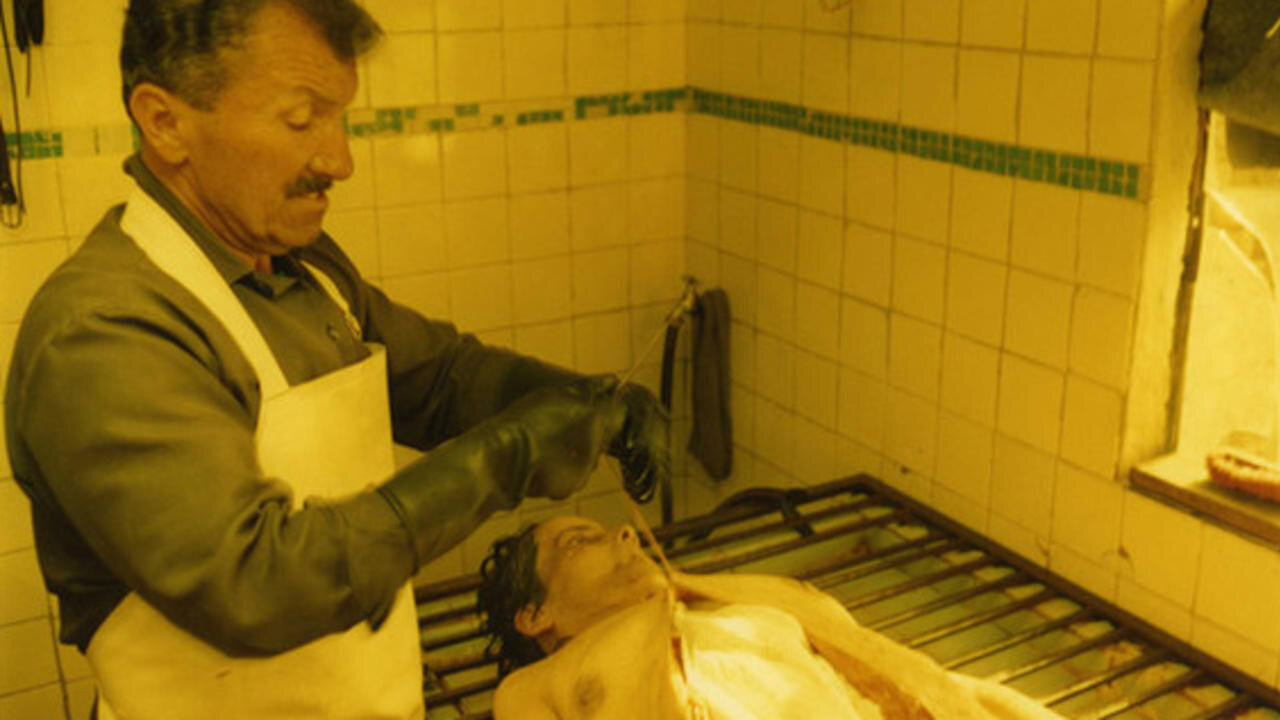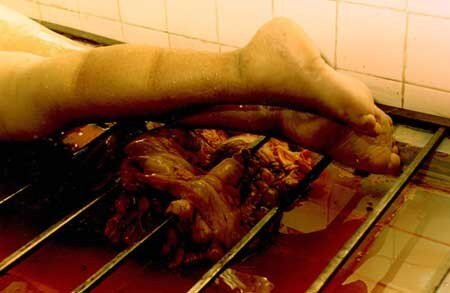[Film Review] Orozco the Embalmer (2001)
Content Warning: This review contains graphic descriptions of dead bodies and mutilation
Documentaries these days tend to be glossy and sensationalized. Stream any docuseries from HBO or Netflix and the picture will be clear, the narrative easy to follow, and even the grisliest of subjects are made palatable through clean editing and slick scores. With current documentaries, the viewer can be anesthetized to crime scene photos and horrific retellings of attacks as the reality of what happened is twice removed from what is shown on screen.
In Kiyotaka Tsurisaki’s 2001 documentary Orozco the Embalmer, the viewer is not given any fuzzed-out death wounds or black boxes over dead faces. The film follows Froilan Orozco Duarte who was, at the time, the busiest embalmer in the world in the most dangerous area in Columbia. Tsurisaki is known for filming and photographing dead bodies, and his focus on Orozco is unbiased and feels slightly removed from the subject matter. It’s easy to see that, with Orozco and Tsurisaki alike, death is an accepted fact of life when one witnesses it every day.
Opening on the poverty-stricken streets of Columbia, bodies rot away under the hot sun as young children play nearby and look on, unphased by the carnage. Unlike the societal norms of Western culture, where death is hidden and even denied, with many unable to process the inevitability of the end of life, the subjects of Orozco the Embalmer cannot deny the presence of death, as it stares them in the face on a daily basis. Crowds gather to watch police turn over a body, likely waiting to see if it is someone they know, and police remove clothing and inspect the body right there in the street, no concern for modesty or exposure.
Orozco the Embalmer is like a fever dream, showing the kind of footage that is so stark in its reality that the viewer can’t help but look away. Orozco himself is an older gentleman who approaches his job in the same way a butcher might. He saws into flesh with a dull blade, and even if you can’t bear to watch him perform, the sound of the rending of flesh forces itself into the imagination. With no voice-over exposition and very little dialogue, the scenes of Orozco performing his embalming duties, often quite crudely, are focused and steady as he removes the viscera from the inside of the bodies, rummaging around and cutting away innards before washing out the hollowed corpse and stuffing it full of rags. Orozco claims that the rags help the body retain its form as opposed to caving in on itself.
After witnessing the first full, stomach-turning embalming, Tsurisaki returns to the streets, the camera focusing on schoolgirls travelling home, cops arresting sex workers, and more bodies as they turn up, victims of violent crime. The majority of the bodies that Orozco works on in the film died of unnatural and violent causes, most often gunshot wounds. It is in this way that the filmmaker shows the viewer the nature of life at that time in Columbia.
Orozco does not see the bodies as people when they come into his shop. At one point a small casket is delivered to him and he pulls a dead baby from within, holding it up by an arm and saying, “look at this little shit, now I’ll knife it.” This feels cruel when watching it, but again, when watching Orozco the Embalmer through the eyes of Western culture, it’s impossible to understand the degree to which death is present in that society, and at an average of 50,000 pesos ($50 USD) per embalming, Orozco is more focused on completing his work quickly and efficiently than with any reverence for the dead.
Orozco the Embalmer is a truly objective view into the effects of violence and the normalization of death on a society that is faced with that reality every day. And despite his somewhat insensitive behaviour while working, Orozco is respected in his community, a well-liked and jovial man who carries his work out as he must, with focus and without veneration.
The big surprise when watching this film is how, in its ninety-minute runtime, the carnage and gruesome nature of Orozco’s work becomes palatable. Toward the end, I found myself able to watch as he performed his duties, no longer compelled to look away. For me, the images became normalized, and I was able to detach myself from my own fear of death, the haunting vision of that dead body on the slats being my own, to watch this elderly man perform a job that no one else wanted to do but was imperative. Orozco the Embalmer is not a film for the faint of heart, but it does provide a unique perspective into a culture and a time in history that should not be overlooked.
Orozco The Embalmer is available from TetroVideo as part of the Shockmentary Collection featuring Junk Films and The Wasteland.




























![[Film Review] Sympathy for the Devil (2023)](https://images.squarespace-cdn.com/content/v1/5fe76a518d20536a3fbd7246/1697186986143-QDVLQZH6517LLST682T8/Screenshot+2023-10-13+at+09.48.52.png)
![[Film Review] V/H/S/85 (2023)](https://images.squarespace-cdn.com/content/v1/5fe76a518d20536a3fbd7246/1697455043249-K64FG0QFAFVOMFHFSECM/MV5BMDVkYmNlNDMtNGQwMS00OThjLTlhZjctZWQ5MzFkZWQxNjY3XkEyXkFqcGdeQXVyMTUzMTg2ODkz._V1_.jpg)
![[Film Review] Kill Your Lover (2023)](https://images.squarespace-cdn.com/content/v1/5fe76a518d20536a3fbd7246/1697465940337-T55VQJWAN4CHHJMXLK32/56_PAIGE_GILMOUR_DAKOTA_HALLWAY_CONFRONTATION.png)
![[Film Review] Shaky Shivers (2022)](https://images.squarespace-cdn.com/content/v1/5fe76a518d20536a3fbd7246/1696442594997-XMJSOKZ9G63TBO8QW47O/Screenshot+2023-10-04+at+18.59.33.png)
![[Film Review] Elevator Game (2023)](https://images.squarespace-cdn.com/content/v1/5fe76a518d20536a3fbd7246/1696440997551-MEV0YZSC7A7GW4UXM5FT/Screenshot+2023-10-04+at+18.31.42.png)
![[Film Review] A Wounded Fawn (2022)](https://images.squarespace-cdn.com/content/v1/5fe76a518d20536a3fbd7246/1695484054446-7R9YKPA0L5ZBHJH4M8BL/Screenshot+2023-09-23+at+16.42.24.png)
![[Film Review] Perpetrator (2023)](https://images.squarespace-cdn.com/content/v1/5fe76a518d20536a3fbd7246/1695483561785-VT1MZOMRR7Z1HJODF6H0/Screenshot+2023-09-23+at+16.32.55.png)
![[Film Review] Mercy Falls (2023)](https://images.squarespace-cdn.com/content/v1/5fe76a518d20536a3fbd7246/1695482997293-E97CW9IABZHT2CPWAJRP/Screenshot+2023-09-23+at+16.27.27.png)

![[Editorial] 10 Films & Events to Catch at Soho Horror Film Fest 2023](https://images.squarespace-cdn.com/content/v1/5fe76a518d20536a3fbd7246/1700819417135-299R7L4P0B676AD3RO1X/Screenshot+2023-11-24+at+09.41.52.png)
![[Editorial] 9 Horror Nintendo Switch Games To Play](https://images.squarespace-cdn.com/content/v1/5fe76a518d20536a3fbd7246/1697214470057-3XZXX8N4LYIMDFWS6Z3P/Screenshot+2023-10-13+at+17.20.13.png)
![[Mother of Fears] Mothering in Silence in A Quiet Place (2018)](https://images.squarespace-cdn.com/content/v1/5fe76a518d20536a3fbd7246/1696445921315-HZJ2DZYQIH6VVWXBO2YL/Screenshot+2023-10-04+at+19.52.29.png)
![[Editorial] 5 Female Focused Horror Book Recommendations](https://images.squarespace-cdn.com/content/v1/5fe76a518d20536a3fbd7246/1696441981361-52EQCTJ7AT2QF1927GM7/919xtm6d3fL._AC_UF894%2C1000_QL80_.jpg)
![[Editorial] 9 Best Slashers Released Within 10 Years of Scream (1996)](https://images.squarespace-cdn.com/content/v1/5fe76a518d20536a3fbd7246/1695478839037-LOFHGVM3H6BMSZW7G83M/Screenshot+2023-09-23+at+15.15.11.png)
![[Mother of Fears] Mother Vs. Monster in Silent Hill (2006)](https://images.squarespace-cdn.com/content/v1/5fe76a518d20536a3fbd7246/1695485781119-H6GNP0G3J2TLPAOIABV7/Screenshot+2023-09-23+at+17.11.56.png)
![[Editorial] 9 Terrifying Cerebral Visions in Horror Movies](https://images.squarespace-cdn.com/content/v1/5fe76a518d20536a3fbd7246/1693509801235-X23OL50T1DVGECH0ZJK2/MV5BMjQ0MTg2MjQ4MV5BMl5BanBnXkFtZTgwMTU3NDgxMTI%40._V1_.jpg)
![[Mother of Fears] I Don’t Wanna Be Buried in a Pet Sematary (1989) and (2019)](https://images.squarespace-cdn.com/content/v1/5fe76a518d20536a3fbd7246/1691328766069-QFNAVJOMFZVZ5CLU1RWM/Screenshot+2023-08-06+at+14.23.13.png)
